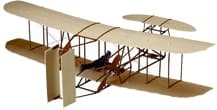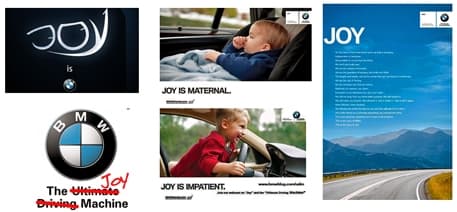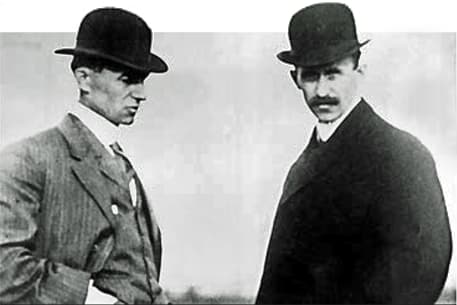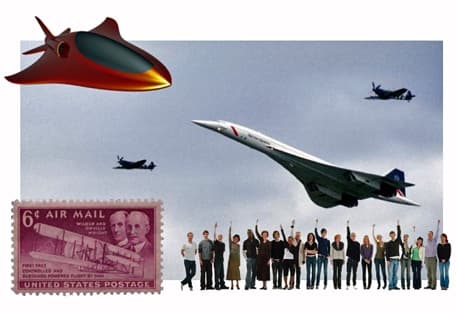The tester’s dilemma: to go on, or give up?
When should we accept that our brilliant idea just isn’t going to work?
- Written by
- Ken Burnett
- Added
- September 01, 2019
This was something entirely new. There was no ‘banker’ to test it against because nothing quite like it had ever been tried before. Still, test it they must.
Few thought they could succeed. To many at the time it seemed foolhardy, little more than wishful thinking. I mean, who’d ever heard of such a thing? What kept the two guys behind it going was a feeling that, really, it should work. In theory, anyway. The benefits were obvious, massive, but the risks, clearly terrifying. Horrible failure loomed large, though nowhere near as large as the lure of the prize. It had to work.
But first, it had to be properly tested.
It was a cold day in Kitty Hawk. The wind was high, the mercury falling. Gingerly, the boys pushed their prototype onto the test track...

The first test ‘When the restraining wire was slipped the machine moved so swiftly I could only stay with it a few feet. It climbed about two feet, stalled and settled 105 feet away. The test lasted just three and a half seconds.’
They would be going nowhere this day. Two days later, after repairs, they tried again.
The second test
‘The puddles outside were covered with ice and the wind was 27 miles per hour. As the day wore on with no improvement we decided we’d better make an attempt. The machine started very slowly then rose suddenly and darted for the ground. The flight lasted just 12 seconds, over a distance of 120 feet...’

The third test ‘The wind had chilled us through so we went to the building to warm up. This flight was much like the last, very much up and down. The duration was just a second longer, but the distance 75 feet greater.
The fourth test
‘This one was steadier, then a sudden gust from the right lifted the machine up 12 to 15 feet and turned it sideways in an alarming manner. It began sidling to the left so I warped the wings down to try to recover balance. The time of this flight was 15 seconds and the distance over 200 feet.’

The fifth test This one so damaged the machine it put paid to further tests that year. But they did stay in the air for 59 seconds and travelled a distance of 852 feet. This though, by their standards, could be conceived a success. It was the first piloted powered flight of a fixed wing machine.
The above quotes, mildly paraphrased in places, come from Orville Wright describing his experiences with his brother and friends at Kitty Hawk in December 1903. The point of the story is that if the brothers had been working for a charity their wonderful, transformational idea would most probably never have taken off because of our tendency to scrap initiatives at the first sign of failure.

Village Neighbours’: we had a wonderful idea for testing an alternative option to child sponsorship – sponsor a village. The link was less personal, perhaps, but not necessarily less engaging. There were all kinds of avenues for inspired testing. The first attempt cost a few thousand pounds and performed poorly, compared to our cash cow, the banker, child sponsorship (developed and refined over decades, it should be said). So Village Neighbours was shelved and never tried again. Shame. I’m convinced now it would have taken off, though maybe not until after the third or even fourth try. The ‘Grandparents’ campaign: this was for an environmental group. We’d identified for them the singular opportunity that no charity ‘owns’ grandparents – a rich territory indeed, we reckoned. Who better to appeal to grandparents, we said, than a charity dedicated to protecting the world their grandchildren will inherit? See here for what the splendid George Smith wrote at the time, as his reaction to the campaign.
We spent months researching and developing the proposition. We called the scheme Evergreens, developed a logo and livery for it and created rafts of appealing materials to launch it. However the client lost interest perhaps because they had, to their mind, bigger fish to fry. We should have pushed harder though. The prize, I believe, is still there to be had. I’ve tried twice to resurrect it with the original client, which is giving them opportunity enough, I reckon.
The ‘Just Add Water’ campaign: the concept was to get major manufacturers with products that require the simple addition of water (shampoos, soaps, whiskies, instant mashed potatoes, etc) to pay for a poster campaign extolling the transformation there would be in Third World communities if we could ‘just add water’. We crafted great visuals for a highly creative poster campaign built around individual leading brands. Only Gillette saw the potential immediately and said they’d maybe give it a try. Discouraged by the perceived indifference of the others and frightened by the potential costs we dithered and the moment was lost. Carpe Diem – sieze the day. We didn’t.
That’s enough failures for now. I’ve got lots more, of course, but some of them might yet be made to work, so I’ll keep my powder dry.
But, I hope the point is made...
© Ken Burnett 2021
This piece first appeared on Ken Burnett’s website in 2012




‘...a sudden gust from the right lifted the machine up 12
to 15 feet and turned it sideways in an alarming manner. It began sidling to the left so I warped the wings down to try to recover balance. The time of this flight was 15 seconds and the distance over 200 feet.’


















